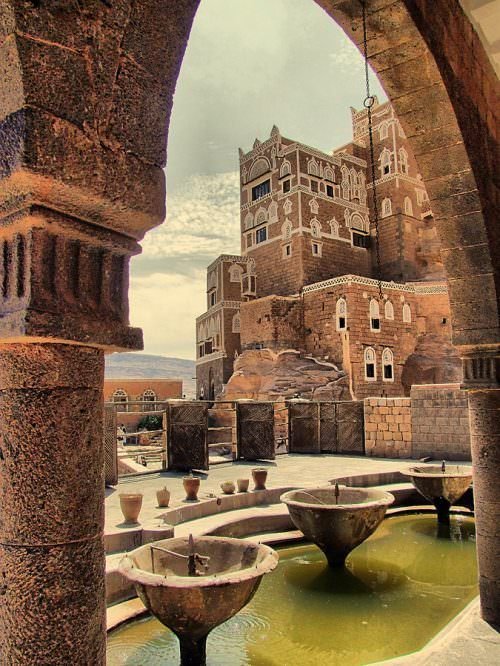info@yemenembassytr.org
Have a question? We're here to answer.
We’re here to answer any question you may have.
Would you like to join our growing team?
info@yemenembassy.com
Would you like to join our growing team?
hello@yemenembassy.com
Error: Contact form not found.
info@yemenembassytr.org
Have a question? We're here to answer.
With its long sea border between eastern and western civilizations, Yemen has long existed at a crossroads of cultures with a strategic location in terms of trade on the west of the Arabian Peninsula. Large settlements for their era existed in the mountains of northern Yemen as early as 5000 BC.
The ancient history of Yemen begins at the end of the second millennium BC, when the Kingdom of Sheba, Ma'in, Qataban, Hadhramaut and Himyar rose and they were responsible for developing one of the oldest alphabets in the world known as the Musnad script. The number of texts, writings and archaeological evidence in Yemen is more than the rest of the regions of the Arabian Peninsula. Call it Rum is the happy Arabic name.
Several states arose in the Middle Ages, such as the Ziyadi state, the Ya`fari state, the Zaidi imama, and the Tahirid state, the strongest of which was the Rasulid state. What is known as northern Yemen became independent from the Ottoman Empire in 1918, and the Yemeni Mutawakkilite Kingdom established its overthrow in 1962 and the establishment of the Yemeni Arab Republic, while southern Yemen remained a British protectorate until 1967 and the establishment of the People's Democratic Republic of Yemen. Yemeni unity was achieved on May 22, 1990.
The Republic of Yemen is located in the south of the Arabian Peninsula in the southwest of the continent of Asia. It is bordered to the north by the Kingdom of Saudi Arabia, to the south by the Arabian Sea and the Gulf of Aden, to the east by the Sultanate of Oman, and to the west by the Red Sea.
Yemen is officially known as the "Republic of Yemen" and its capital is Sana'a Governorate, and after the Houthi coup in September 2014, the President of the Republic declared Aden Governorate as the temporary capital of the country.

Republican and democratic. The people are the owners of power and its source. They exercise it directly through referendum and general elections. They also exercise it indirectly through the legislative, executive and judicial bodies and through elected local councils. The political system in the Republic of Yemen is based on political and partisan pluralism. The transfer of power and participation in it takes place peacefully through general elections.
The President of the Republic of Yemen is the head of the state. He is directly elected by the people in competitive elections in which a number of candidates participate. For the President of the Republic to win, he is required to obtain a majority of the votes. The presidential term is seven years, starting from the date of taking the constitutional oath, and it is not permissible for one person to assume the position of President of the Republic for more than two presidential terms.
The Yemeni constitution states that the state is democratic, endorses partisan and political pluralism, adopts a free economic system, adheres to international covenants and covenants stipulated in the Universal Declaration of Human Rights, and that Islamic law is the main source of legislation. Yemen is a member of the League of Arab States, the United Nations, the Non-Aligned Movement, the Organization of Islamic Cooperation and the World Trade Organization.
Rectangular in shape, its width is two-thirds of its length. It consists of three rectangles of equal dimensions along the length of the flag, the top of which is red, the middle is white, and the third is black.
The current flag of the Republic of Yemen was adopted on May 22, 1990, the day on which South Yemen, known as the People's Democratic Republic of Yemen, was unified with North Yemen known as the Republic. Yemeni Arabic.
Yemen flag consists of the red, white and black colors of the Arab liberation flag, which have been used since July 23, 1952 in several Arab countries, the first of which was Egypt after the victory of the 1952 revolution.
By air: (Sana'a International Airport - Aden International Airport - Taiz International Airport - Hodeidah International Airport - Mukalla International Airport - Seiyun International Airport).
By land: (Haradh port - Al-Baqa'a port - Albeen port - Shehn port - Sarfeet port - Al-Wadiah port).
By sea: (Aden Port - Mokha Port - Hodeidah Port - Mukalla Port - Nishtun Port - Qishn Sihut Port - Al-Dhaba Port - Bir Ali Port - Balhaf Port - Radhum Port - Dhubab Port - Al-Khawkhah Port - Al-Salif Port - Ras Issa Port - Al-Khouba Port - Beard port - Midi port).
Religion: Islam is the country religion
language: Arabic is the official language.
National Currency: Yemeni Riyal
Local time: +3 hours from GMT all year round
Electricity: 220 Volt / 250 Hz
Yemen international dialing: +967
Adding {{itemName}} to cart
Added {{itemName}} to cart